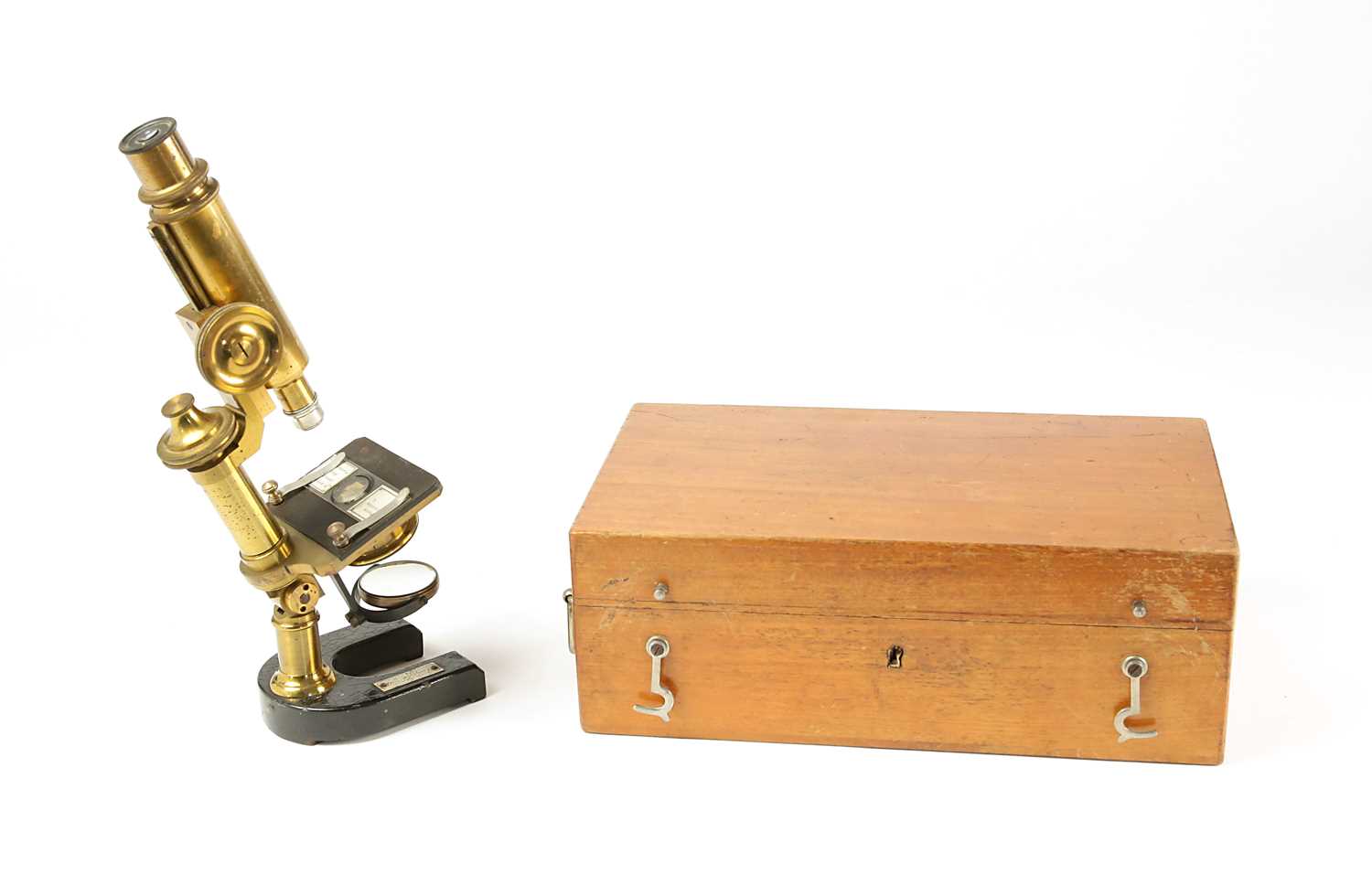1st May, 2000 12:00
Instruments of Science and Technology
121
A Paul Waechter Brass Monocular Microscope, circa 1900
A Paul Waechter Brass Monocular Microscope.
Berlin, Germany, circa 1900.
Brass microscope, with painted base, three objectives, five oculars, contained in original wooden case.
Measurement: H. 32 cm.
catalogue Note: Paul Waechter (1846 - 1893) was trained to be an optician and mechanic at the famous Zeiss Optical Workshop in Jena, Germany. In 1872, Waechter founded his own optical workshop at Köpnicker Strasse No. 115 in Berlin. In the year 1886, Waechter published advertisements for his microscopes in the scientific Literature that included the phrase, “Student of Dr. Zeiss.” His earlier instruments were signed in script on the body tube either, “Paul Waechter in Berlin” or more simply, “Paul Waechter, Berlin.” By the year 1890, demand for his microscopes had increased to such and extent that he moved his workshop to larger facilities in Friedenau, Berlin, first at Albe Strasse 21 and then at Nied Strasse 19. The company remained at Friedenau on into the early years of the 20th Century. At this time, the usiness was named 'Optische Werkstaette Paul Waechter,' although Waechter died about 1893. Microscopes produced by the company during this period often did not bear a signature or serial number on the microscope itself, but this information was usually found on the the wood case that normally accompanied the instrument, as it was for other makers like Schieck. The serial number of the instrument was usually stamped on the lip of the case and inside the lid of the case was a paper label bearing the name of the manufacturer as Waechter along with a magnification table. Between the years 1872 and 1892, Waechter produced over 20,000 microscopes, mostly for the examination of trichinae in meat. It was the famous scientist, Rudolph Virchow (1821 – 1902) who, in circa 1870, succeeded in inducing various German states to make compulsory the testing of pork for Trichinosis in abattoirs (slaughter houses). Waechter and several other German microscope manufacturers designed and produced microscopes especially to meet this need. Many of these instruments were exported outside of Europe including to the USA. An advertisement shown here, is from the German periodical entitled, 'Zeitschrift fur Wissenschaftliche Mikroskopie und Mikroskopische Technik,' which is available on the internet. By the mid-1930s, the business was taken over by the Pridat family and the optical workshop was moved from Berlin to Potsdam in what is now the nation of Poland (formerly the German State of Prussia).
Estimate: 150-300
Sold for €1,381
A Paul Waechter Brass Monocular Microscope.
Berlin, Germany, circa 1900.
Brass microscope, with painted base, three objectives, five oculars, contained in original wooden case.
Measurement: H. 32 cm.
catalogue Note: Paul Waechter (1846 - 1893) was trained to be an optician and mechanic at the famous Zeiss Optical Workshop in Jena, Germany. In 1872, Waechter founded his own optical workshop at Köpnicker Strasse No. 115 in Berlin. In the year 1886, Waechter published advertisements for his microscopes in the scientific Literature that included the phrase, “Student of Dr. Zeiss.” His earlier instruments were signed in script on the body tube either, “Paul Waechter in Berlin” or more simply, “Paul Waechter, Berlin.” By the year 1890, demand for his microscopes had increased to such and extent that he moved his workshop to larger facilities in Friedenau, Berlin, first at Albe Strasse 21 and then at Nied Strasse 19. The company remained at Friedenau on into the early years of the 20th Century. At this time, the usiness was named 'Optische Werkstaette Paul Waechter,' although Waechter died about 1893. Microscopes produced by the company during this period often did not bear a signature or serial number on the microscope itself, but this information was usually found on the the wood case that normally accompanied the instrument, as it was for other makers like Schieck. The serial number of the instrument was usually stamped on the lip of the case and inside the lid of the case was a paper label bearing the name of the manufacturer as Waechter along with a magnification table. Between the years 1872 and 1892, Waechter produced over 20,000 microscopes, mostly for the examination of trichinae in meat. It was the famous scientist, Rudolph Virchow (1821 – 1902) who, in circa 1870, succeeded in inducing various German states to make compulsory the testing of pork for Trichinosis in abattoirs (slaughter houses). Waechter and several other German microscope manufacturers designed and produced microscopes especially to meet this need. Many of these instruments were exported outside of Europe including to the USA. An advertisement shown here, is from the German periodical entitled, 'Zeitschrift fur Wissenschaftliche Mikroskopie und Mikroskopische Technik,' which is available on the internet. By the mid-1930s, the business was taken over by the Pridat family and the optical workshop was moved from Berlin to Potsdam in what is now the nation of Poland (formerly the German State of Prussia).
Estimate: 150-300
Auction: Instruments of Science and Technology, 1st May, 2000
Hessink's proudly presents the sale of a fine single owner collection of Instruments of Science and Technology. The sale offers you a great opportunity to purchase beautiful selection of globes, microscopes, telescopes, medical, drawing, surveying and navigational instruments from famous instrument makersfrom the 17th to the 20th century.
